The internet gets flooded with new information every second. According to Worldometer, at least 7 million blog posts are published every day (as of August 2020), and that’s just those using WordPress. By the time you've finished reading this paragraph, five thousand posts have already been published.
With this much content released daily, it's expected that most people overlook a lot of articles, images, videos, and infographics. It is therefore not impossible for audiences to pay little or no attention to most of the content they encounter online.
While people ignore a lot of content they come across on the internet, there are few we stumble upon and can't help but share. It’s so interesting, entertaining, or engaging that we simply can’t help ourselves; it’s like an itch that you have to scratch, thereby ignorantly becoming a small part of the sophisticated machinery that turns a simple piece of content into a viral one. This is called viral marketing.
Table of Contents
What is Viral Marketing?
How Does Viral Marketing Work?
What Makes Content Go Viral?
Importance of Viral Content in Marketing
Steps to Creating A Successful Viral Campaign
Examples Of Successful Viral Content Campaigns And Why They Worked
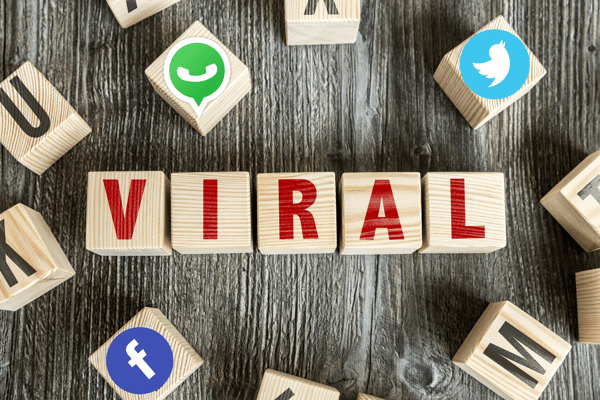
What is Viral Marketing?
Due to advancements in the digital era, business marketing has changed significantly. In the past, marketers relied on traditional methods of promoting and outbound marketing, which in most cases, were quite expensive and took time. Now, more and more businesses are moving beyond the old techniques, and are creating more strategic, targeted, and competent methods to capture the attention of readers and lead them towards conversion.
One such recent strategy that has become popular in today's marketing world is the use of viral contents, through a process known as Viral Marketing.
Viral marketing is basically what its name implies – marketing that rapidly spreads like a virus.
This term was coined by two venture capitalists known as Tim Draper and Steve Jurvetson, who used the word 'viral' to describe the exclusive referral-marketing technique behind Hotmail's growth in 1996.
Viral content, the main element in this form of marketing, describes a piece of online content that spreads very quickly across the internet and generates a high level of public awareness. This comes as a result of sharing and exposure on social media platforms, search engines, news websites, aggregators, and email newsletters. These contents could be in the form of videos, articles, images, or infographics.
Viral Marketing is therefore a type of advertising which relies on a multitude of people sharing a piece of content which, as an end-result, promotes a brand, company, product, or service. The people doing so must not be related to the company and are not being paid to share the content. They are sharing out of sheer interest.
It’s like free advertising!
How Does Viral Marketing Work?
Viral marketing works very differently from other forms of classic advertising. A content could go viral by chance or through strategic calculations and planning.
In the case of accidental virality, the creator, which could be the brand owner or not, simply uploads the content with the aim of just sharing. And then it suddenly goes highly popular, much to the surprise of the uploader and delight of the brand owner (if there is a brand included in the viral content).
A good example of accidental virality is in the case of GoPro. A cameraman set up his GoPro camera by a riverbank, hoping to get some close-up shots of a grizzly bear while filming a wildlife documentary for BBC, only to have his camera chewed on by a grizzly.
 Amazingly, the camera remained unharmed, and he uploaded the unusual video on his Youtube page. It became highly popular in no time. The company never expected it. They featured it on their own portal, which generated millions of views and significantly promoted their brand name without spending a lot of money on advertising.
Amazingly, the camera remained unharmed, and he uploaded the unusual video on his Youtube page. It became highly popular in no time. The company never expected it. They featured it on their own portal, which generated millions of views and significantly promoted their brand name without spending a lot of money on advertising.
In viral content, is not entirely obvious who the sender is and who the intended recipients are. This is very much unlike traditional advertising on TV, radio, and website banners where advertisers are already perceived and audiences are targeted.
Also, it is not something you can easily control.
Since the recipients themselves do the advertising, albeit unknowingly, viral marketing is often perceived as word-of-mouth. As it turns out, such content is more acceptable to the audience since it has been recommended by a friend or a family member. In other words, the audience goes from being passive recipients to active promoters of the advertising content.
So essentially, viral marketing have three stages:
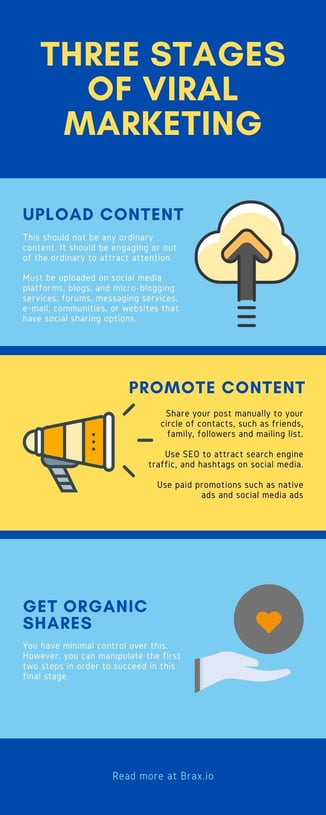
1. You upload any kind of content publicly.
This should not be any ordinary content. It should be engaging or out of the ordinary to attract attention (such as in the case of the grizzly bear eating the camera).
Of course, the post should be made public so that anyone can see it. There should also be a means to share it. The channels used for viral marketing often have social components, such as social media platforms, blogs, and micro-blogging services, forums, messaging services, e-mail, communities, or websites that have social sharing options.
2. You promote your content.
You need to get some eyes on your content first. You can do this by sharing the post to a circle of people that is already within your reach, such as your friends and family, your followers, or to your mailing list.
You can also make use of easily searchable keywords, terms, or popular hashtags so that you’ll receive organic viewers.
If you’ve got the budget, you can use paid ads to promote the post. The most common forms of advertising used for viral marketing are native ads and social media ads.
3. Your content gets a massive number of organic shares.
This part you have minimal control over. However, you can manipulate the first two steps in order to succeed in this final stage or viral marketing.
Sounds easy? Yes.
Is it easy? No.
Bear in mind that there is a multitude of shareable materials available on the internet every day. Take for instance on YouTube. This video platform gets over 12,000 hours of video content uploaded every hour. For this reason, creating a viral campaign requires more effort than you would expect, as your content has to really stand out.
While other brands may not be so fortunate as our GoPro example, they could still successfully go viral through calculated means.
What Makes Content Go Viral?
Considering how advanced the world has become in terms of communication, you would expect content virality to be an easy thing to achieve. However, not every content has what it takes to become viral. So, what makes a piece of content viral worthy?
When a piece of content goes viral, it often remains in the public consciousness for a considerable amount of time. If you want to reach a large audience, whether, for the purpose of marketing or promotion or just to show the world something amazing, it is important to understand what makes content go viral. This can help you get started on the right path.
Content could go viral as a result of a very good promotion or sometimes, just blind luck. Nevertheless, if you want to achieve a higher chance of going viral, utilize any of the following on your posts:
-
Arouse intense emotions
A study carried out by Johan Berger and Katherine Milkman from the University of Pennsylvania on almost seven thousand New York Times articles revealed that viral articles evoked very arousing emotions like amazement, excitement, or amusement.
Contents that made readers feel inspired, excited, or amused had a higher chance of being shared than contents that evoked contentment.
The same research revealed that contents that induced negative emotions such as anxiety and anger were highly shared too.
The conclusion that can be drawn from this is that irrespective of the kind of emotions that online contents evoke, as long as readers and viewers are not left sitting on the fence after engaging with your material, there is a very good probability that it will be shared.
Sharing content with a clear emotional disposition allows the audience to take a side and share what resonates with them.
-
Practicality
Content is more likely to be shared when the information in it is practical, useful, educational, and simple.
A study carried out by Milkman and Berger on what makes content go viral notes that people derive pleasure in sharing practically useful content for altruistic reasons, social exchange, or self-development.
For this reason, how-to contents and infographics are quite popular because they often contain clear strategies that readers can apply immediately.
-
Readability
Readability is an important feature of viral content. Even if your content contains the most revolutionary information, it isn't of much use to the public if it is not easily digestible.
A good way to find out how readable an article is would be to run it through a readability test. Ideally, your content should be understandable to a ninth-grader in order to appeal to the largest audience.
Authors of viral content like Tim Ferriss and Malcolm Gladwell write below the ninth-grade level. Bear in mind that making your content easy to understand does not mean simplifying what your content is about. You can portray sophisticated information in very simple words and shorter sentences to achieve a better readability score.
-
Credibility
Content is worth sharing when it is trustworthy. A good way to build credibility within your content would be to quote experts in your field while citing statistics and sources.
Although it is possible to establish a connection with people by telling personal stories, more trust is attained when the stories are backed up with additional reliable sources.
Some popular bloggers reach out to influencers to include them in a piece of content in exchange for social sharing. Experts in different fields are more likely to share content with their wide audience when they are included in it.

In line with this, the brand could make the audience aware that it is an advertisement, or only reveal the brand at the end of the content. In cases of the concealed method of content dispersal, the brand has to be careful to make sure the audience doesn't feel tricked as this could backfire and defeat the whole purpose of the marketing campaign.
-
Trigger
Viral contents often contain triggering words in their title and introduction to hook the audience and get them to pass the article on. Power words trigger either excitement, anger, fear, greed, encouragement, lust, or safety and pull the attention of readers immediately.
One principle that journalists follow is creating content based on what people already have at the front of their minds. That way, it is easier to trigger a certain kind of emotion and cause them to share.
-
Visual appeal
Visuals, in this case, include not only images but also typography and layout. Long paragraphs often discourage readers, while short pieces of content surrounded by white space are mentally less cluttering.
Viral contents contain headings in large fonts along with short and well-spaced paragraphs grouped into bold subheadings. Alexander Tochilovsky, an instructor at the Cooper Union School of Art, told The Week that many factors such as font size, letter and word spacing, interline spacing, column width, and justification, play a crucial role in determining how readable a passage is.
If you’re advertising your content, it would be great to perform a multivariate test to see which style works best.
How Important is Viral Content In Marketing?
Viral marketing is based on the concept of word-of-mouth to increase awareness of a brand's products and services. It capitalizes on social media to benefit product sales through a strategically designed viral process known as a Viral Campaign.
These viral campaigns ensure that well-designed content (which may include video clips, articles, or images) about the product reaches new audiences and generates more leads, thereby enhancing the rapid growth of a business.
There are several important roles viral content play in marketing, and these are as follows:
-
Lower advertising costs
Businesses often lookout for marketing campaigns that won't cut too deep in their pockets. Viral marketing remains the most effective and yet cheapest method of business promotion.
A lot of times, the use of viral content may require a little investment and push at the beginning of the campaign in terms of content production and paid promotions. But once your expertly constructed content reaches the public, the rest is done by your audience. Advertising costs automatically drop to almost nothing.
Also, future campaigns by the same brand become more likely to reach a broad audience in a short time due to familiarity with your brand that would have developed.
-
More growth in lesser time
Ordinarily, achieving business success is quite difficult. In cases where it seems like businesses achieve success overnight, it is often as a result of years of hard work and failed attempts.
Viral marketing, however, is one of the very few techniques marketers can employ to attain explosive business growth is a very short period of time. Once viral marketing exposes your product to a good percentage of the public, a lot of people are driven to your website leading to higher traffic, improved rate of conversion, and, in the end, more sales and profit.

-
Greater exposure
One of the most significant advantages of viral marketing is the potential it has to expose your product to mainstream outlets. Being a type of inbound marketing, the use of viral online content easily brings a vast amount of awareness to a business, and a lot of marketers may claim not to need mainstream media to achieve that.
But who would deny the enormous advantage the influence of mainstream media could have on a business? With a successful viral marketing campaign, your business will create a certain kind of buzz all over the media, thereby making your product or service worthy of being featured on more prominent platforms without the need even to ask. Remember the GoPro example above? News outlets from all over the world wrote articles about what happened, and none of those are paid!
More recognized platforms have a bigger audience that could be directed towards your business, thereby resulting (again!) in more conversions and profit.
-
Increased trust
Your audience will be more willing to give your product a try when they consider your brand credible. In every form of marketing, recognition creates a sense of trust and acceptance in consumers.
When your product goes viral, more people become aware of it, and the popularity adds credibility to your brand. Viral marketing works explicitly well in enhancing brand trust because the virality is based on sharing and personal recommendations between individuals. Remember, people are more likely to trust a brand recommended by someone they trust.
-
Generates more leads and traffic
The generation of more traffic and leads is one of the most apparent benefits of viral marketing. When your content goes viral, it inevitably generates more traffic.
Although most businesses that employ the viral marketing strategy aim for sales, yet there is no denying the fact that leads also have a significant role to play in the success of a business.
When your content goes viral, many people develop the interest to find out what the excitement is all about. And although they may not be ready to make a purchase yet, they could still sign up and keep your brand in mind for when they are ready, thereby increasing your customer list.
A quality customer list is different from the general audience because people who have registered for your service or made purchases are more likely to try out new products than potential customers. B2B and service-based businesses often generate more leads from viral marketing than actual customers, but if they have a very good marketing funnel, this can easily turn into a warm list.
-
Less invasiveness
People often feel that business adverts invade their space, especially when they seem to come across it on every site they land on. This could come off as offensive to some people and permanently ignore your product or service even if they currently need what you offer.
The great thing about viral marketing is how business popularity is achieved as a result of sharing. Since the consumers are the ones sharing the content, there is very little chance it would come off as invasive. This is very much like how native advertising works, except that you no longer need to pay.
Even when some users extensively recommend your product or service, your brand will only appear as an innocent element being pushed forward by an enthusiastic user. In general, viral marketing gives your brand a better perception when compared to other traditional methods of advertising.
-
Less Fraud
Because the traffic is mostly organic and comes from shares, there is less chance of getting bot and fraudulent traffic. When it comes to promoting affiliates offers, your advertiser will surely love you for sending real people to their offers.
Remember that with affiliate marketing, high traffic volume, high amount of conversions, and high-quality traffic can ensure a better business relationship.
-
Increased sales or paid subscriptions
Viral marketing is one of the most effective techniques you could apply to attract people to your brand. Awareness is one of the first steps to getting conversions.
With a well-strategized viral marketing campaign, your brand gets exposed to a vast number of people, a good number of which would be willing to try out your product, thereby leading to more conversions.
-
Continuity
The internet can retain information for a very long period, if not forever. Any content worthy of going viral is also worthy of remaining on the internet for a long time.
Although the buzz around a viral content may diminish after a while, as long as it remains on the internet, there is a good chance someone from a younger generation would find it and feel the need to share, thereby igniting the cycle again.
When this happens, you won't have to lift a finger to get your offer into the limelight and conversions rolling again. That being said, creating astounding content is advantageous to the present and future of any business.
Steps to Creating A Successful Viral Campaign
Undoubtedly, many pieces of content have gone viral by accident. But it is still possible to use your knowledge to manipulate a similar outcome. In reality, a lot of viral posts are just a result of effective marketing strategies, and you may not even realize that you’ve become part of the machinery!
In order to make your brand content spread across the web and reach a massive amount of people, there are a lot of things you have to put into consideration, and they are outlined below in-depth.
1. Have Good Knowledge Of The Target Audience
Before creating viral content, you must first have a good knowledge of your target audience, because the key to a viral campaign lies in how well the content convinces users to share.
An excellent way to create content that triggers your target audience is to create a representative persona that includes psychographic, demographic, and social information, as well as content preferences.
To build an accurate marketing persona, you must communicate with real and prospective customers to find out what interests them and what is of importance to them when they make purchases and share content online.
Knowing what triggers your audience to take action is the first step to creating a successful viral campaign.
Below are practical approaches you can take to learn about your audience:
-
Question your assumptions.
Many marketers make the mistake of assuming their target audience, don't. For example, if you have decided to target middle-aged men, ask yourself why. You may have thought wrongly about the messages or styles that appeal to them. Questioning your assumptions is the most critical step in learning about your audience because it may help you redefine your target audience. -
Do some research.
You could carry out simple research on what others have found. Take some time and read up on relevant case studies, examples, and psychological analyses carried out by general market researchers, reporters, and sociologists. Learning about what marketers before have found helps in gaining quick extensive knowledge about your audiences and starts you off in the right direction. -
Create a persona.
After collecting enough objective data from literature research, the next step would be to create a customer persona. Ideally, your fictional persona should exhibit all the traits expected of an average member of your target audience, and this should include factors such as sex, education level, age, income, and character factors such as curiosity, temperament, or sensitivity. -
Carry out measurable data analysis.
To support your persona assumptions, you have to carry out a large-scale analysis in the form of surveys. Your survey should cover the broadest cross-section of your assumed audience and should be in the form of multiple-choice questions to help accommodate all the various options.
The questions asked should be relevant to your product type and brand and should provide you with objective data about the habits of your audience. An example of such questions is 'What would you consider first when purchasing an X?' -
Carry out observational analysis.
After carrying out broad quantitative research, you should carry out a small-scale analysis to complement the data previously gathered. This type of research won't give you objective data but will provide you with further insight into the psychological makeup of your audience. Your research should cover a small sample with the use of open-ended questions to get lengthy responses you could easily interpret. An example of such questions that could be asked here is, 'What comes to your mind when you see this image?' -
Observe your competitors.
Ensure you observe your competitors. Most times, they would have already done similar market research and implemented it. If your competitors also target the same audience as you, take note of the way they write and advertise to their potential customers. You may learn a lot from it. However, try to distinguish your brand. -
Observe other products and services.
Another good way to learn about the right approach to your target audience is by observing the way other products and services present themselves. The products and services don't have to be related to your industry, just something they already use. The aim is to learn the kind of messaging that gets to your target audience and the right position to take. -
Listen to social conversations and examine interactions with your brand.
Find out what your customers and prospects are saying online, including the topics they are following most closely and the brands they usually interact with and why. You can do this by making use of a social listening software and a targeted social list. You could also make use of the social listening software in combination with Google Analytics to examine how users behave on your site and how your target demographics are interacting with your brand. The data obtained from these observations can then be used to create a better approach to your audience.
None of these methods alone can give you a perfect understanding of your average target customer because populations vary and are quite unpredictable. It's always best to gather data from multiple sources and combine them into a comprehensive vision to enable you to create what appeals to your audience while allowing for some room to grow since audience behavior may change from time to time.
If you’re using native advertising to target your audience, have a look at the native advertising targeting options we have compiled.
2. Select The Appropriate Platform For Your Content
Viral content capitalizes on social sharing for success. Nevertheless, not all kinds of social platforms may be suitable for a particular product. The type of platform you choose to post on will determine the nature of your content.
Instagram, Youtube, Facebook, LinkedIn, and even your own website are all excellent examples of platforms for viral marketing; however, the types of content that thrive on each platform vary.
For example, if you decide to use Instagram for your marketing campaign, your viral content will comprise of series of Instagram stories or images with persuasive captions that cause users to share online. On the other hand, if you choose to use LinkedIn, your content will be in the form of an article. When you’re using your own website though, you are not limited to the type of content you want to share.
Ideally, the platform you decide to use for your viral campaign will depend on the information you must have gathered about your target audience. When choosing the best venue for your marketing campaign, you should consider if this platform will broadcast the type of media that suits your business. Similarly, think about whether this platform is where you can actually reach your audience and not just the general public.
For instance, would posting an image on Instagram be helpful for a recruitment company looking for applicants? It might help. But for the best results, you should go for LinkedIn.
Below is a brief overview of different platforms capable of meeting your business needs: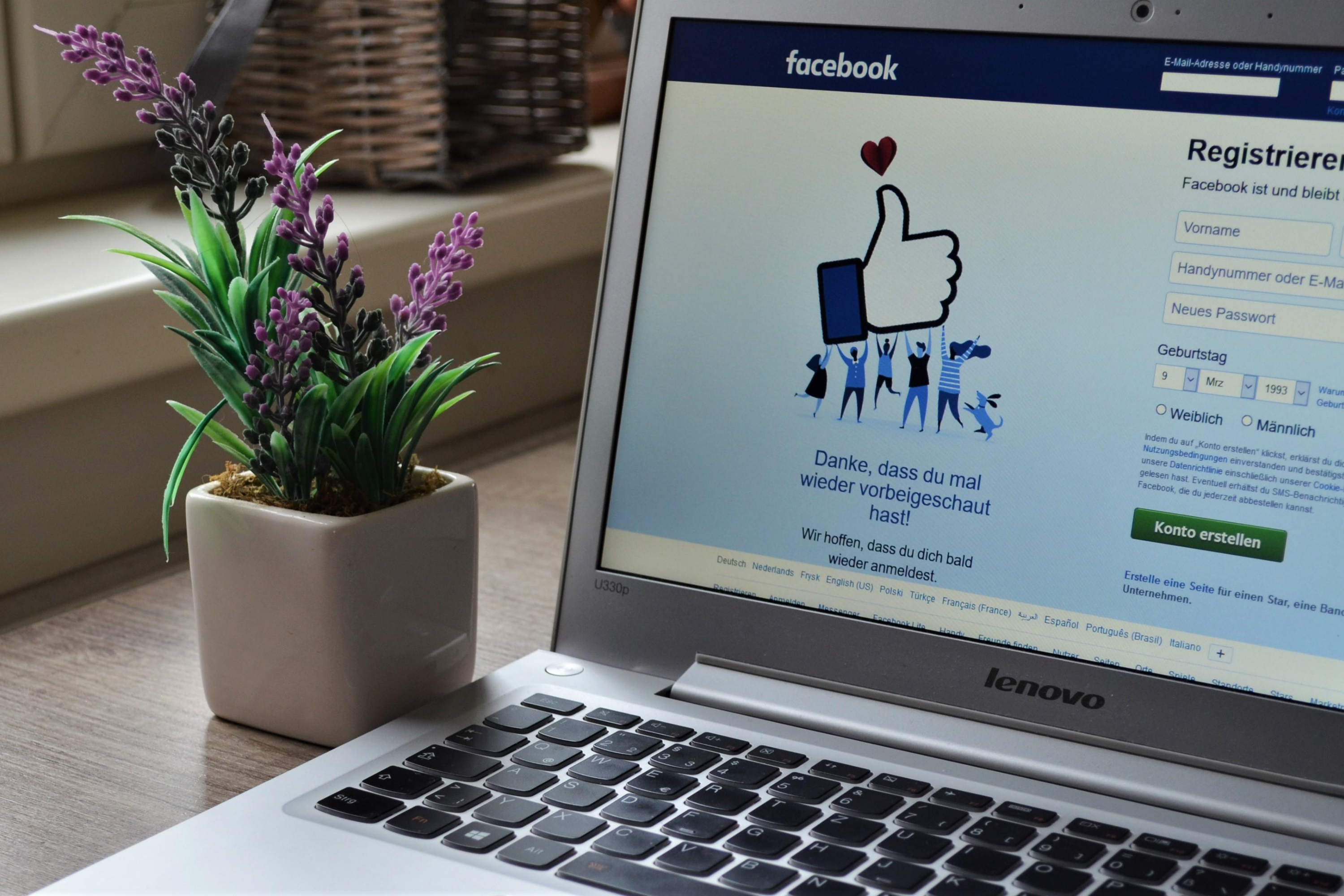
-
Facebook
Facebook is, without a doubt, one of the most powerful social media platforms in the world. It's easy to assume most people are on Facebook, and for this reason, it is a very useful tool for marketing. With Facebook, brands can present themselves in various ways to the consumers and build long-term commitments with them.
The primary goal of using Facebook in your marketing campaign shouldn't be just to sell. Since this platform works better in building relationships, your business can leverage it to let customers know the people behind the brand.
The kind of content posted on Facebook should be more friendly to let customers view your company as an ideal place to work, as this always affects how consumers view your brand. If used correctly, Facebook could help your business gather a lot of loyal fans who would be willing to share your content.
With a well constructed viral content coupled with the vast Facebook network, your content could reach millions of people across the internet in a short time.
Viral content designed for Facebook marketing should be authentic and reflect the actual image of the company, to encourage user engagement. Below are some of the statistics to consider:
- With 2.41 billion users each month, Facebook has the highest number of users in comparison with other social networks and is the world's third most visited website.
- According to Pew Research, 52% of U.S adults use Facebook as their news source.
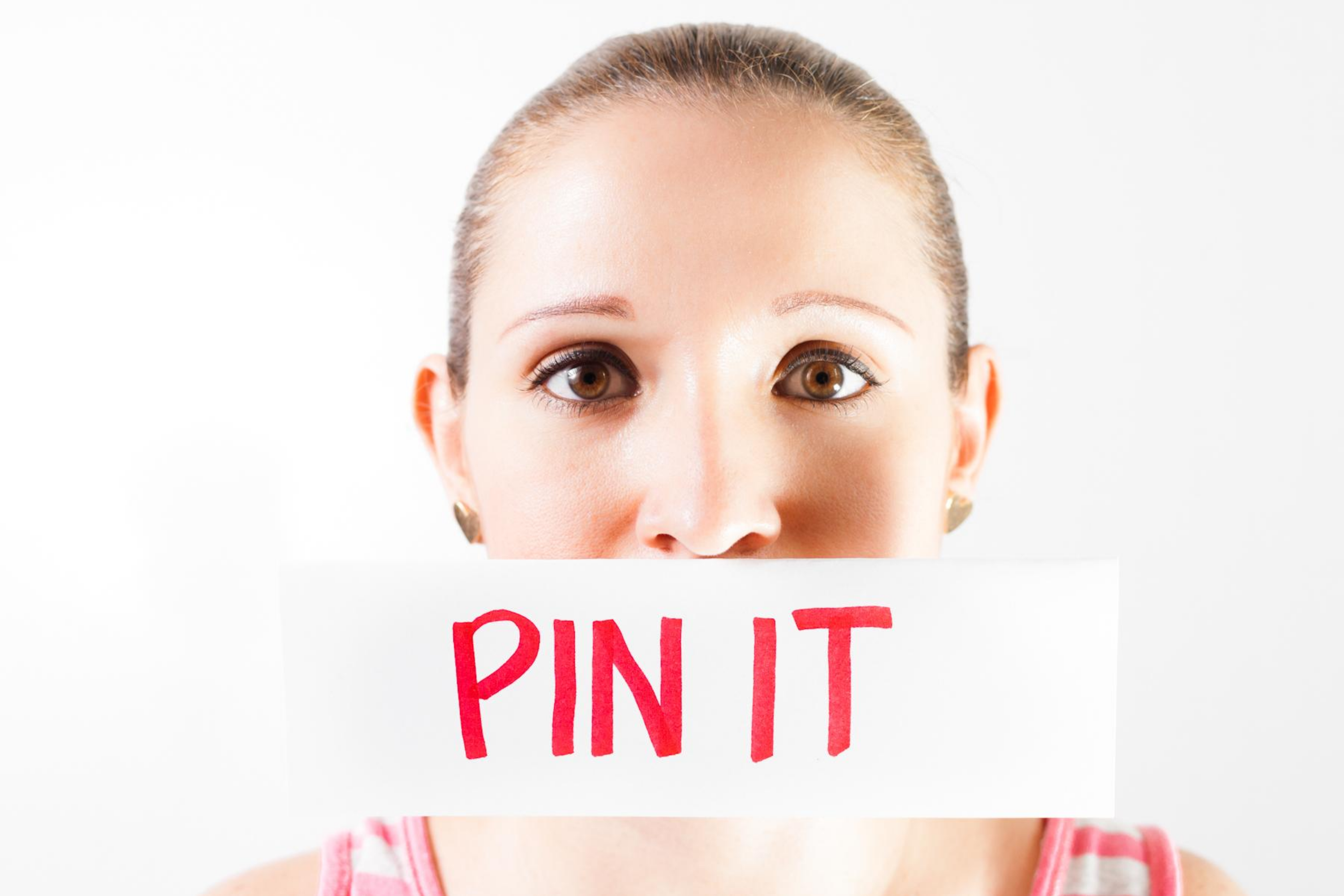
-
Pinterest
Pinterest is a platform not just for sharing photos and videos, but actual website links. It is actually more of a search engine that is socially curated.
Members are allowed to pin various visual contents to their pinboards, along with links to the webpages from which the material came. Pinboards are linked to members' profile pages to enable people interested in the content to view the person, business, or brand behind it.
Pinterest is dominated by females and is a great platform to advertise products that have visual imagery as its primary selling point. Niches that work well with Pinterest include wedding planning, interior decorations, fashion, travel destinations, and food. This is because you can say a great deal about products related to these niches with just stunning photos and videos.
A lot of people tend to overlook Pinterest as a social media platform that could be utilized in marketing because of how huge it is. There are millions of pins in virtually any niche you could possibly think of, with the number rising each day.
Here are some statistics which prove that Pinterest is one of the most useful platforms for marketing:
- Pinterest has more than 200 million active users every month.
- Out of these active users, about 2 million of them post pins daily, resulting in a total of over 100 billion pins on Pinterest currently.
- Two-third of these pins are from products and brands.
- Although a lot of these pins are from products and brands, seventy-three percent of Pinterest users appreciate it and say brand contents add more value to the platform.
- Pinterest drives about five percent of all website referral traffic, which is the second most significant portion of web referral traffic, among other social networks.
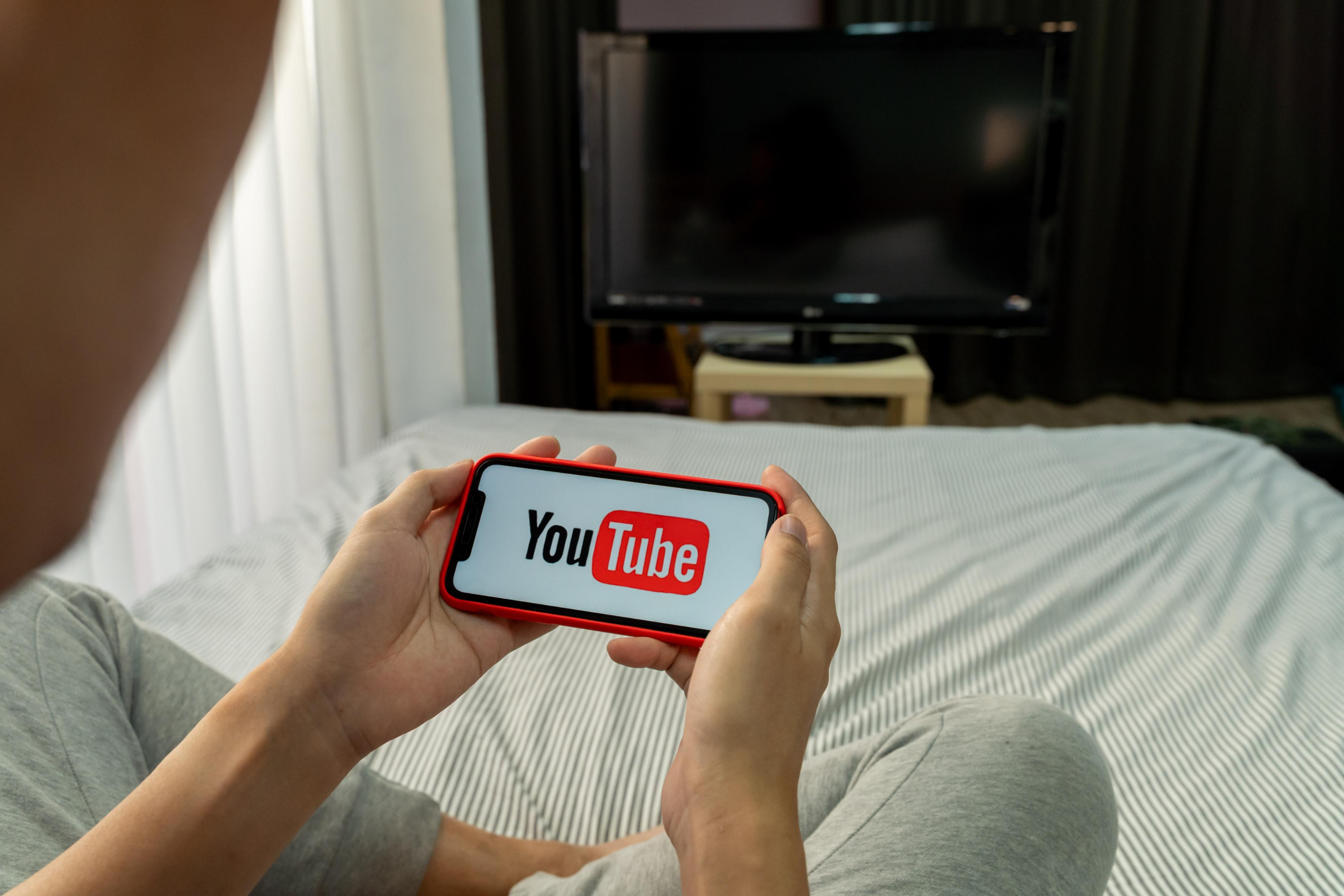
-
YouTube
YouTube is one of the most powerful tools in marketing. Just like Pinterest, marketers can make use of YouTube to exploit our love of visuals fascinatingly. Homemade and company-made videos are uploaded on this platform daily, and many have gone viral through this means.
With millions of people viewing this platform every day, it is not easy to get your marketing content to go viral. For YouTube to work effectively in marketing, you have to portray your brand uniquely and unforgettably to give viewers reasons to share your content. No one will be encouraged to share a basic and boring video, no matter how useful your product may be.
Before using YouTube for your viral campaign, you could watch some viral YouTube videos to get an idea of what people love to see. Videos that teach people how to do things, those that exhibit products or services, or those that introduce a very unique product get a good number of shares.
Some YouTube statistics to consider are as follows:
- YouTube is one of the most used online platforms in the U.S, with 73% of adults actively engaging with this platform, which is more than Facebook.
- The time people spend watching videos on 'which product to buy' has significantly increased. About 80% of people who watched a product-related video did so before buying.
- After Netflix, YouTube is the second most preferred platform for watching online videos via TV screens for people between the ages of 18 and 34.
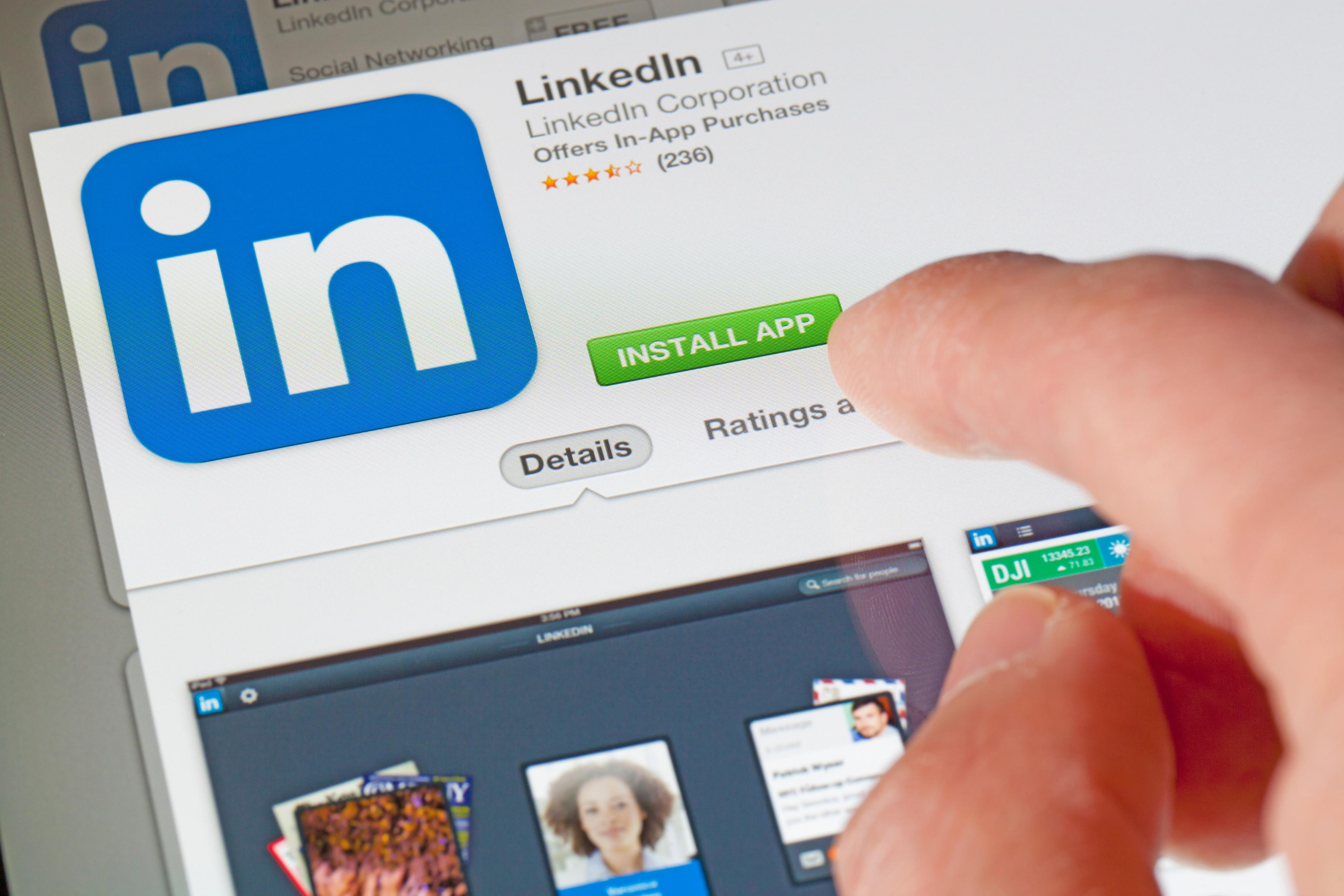
-
LinkedIn
LinkedIn may not be one of the first platforms that come to mind when you think of Viral Marketing. However, publishing on LinkedIn has many benefits. This social platform was created to serve as a way to grow and utilize business connections.
Since consumers are already on this platform to stay updated on business news and trends, marketers can take advantage of this by creating viral content that would meet the needs of the consumers. If what you offer focuses on B2B and B2C, this is a great place to start.
Viral contents on LinkedIn could be in the form of links to interest articles or blog posts about your campaign. Here are some LinkedIn statistics to consider:
- About 106 million LinkedIn users log in monthly and engage with content they find on the platform.
- More than 75 percent of LinkedIn users earn over $50,000, making this platform an excellent place to get loyal users who are willing to buy and recommend.
- About 50 percent of B2B buyers use LinkedIn when deciding what to buy, and 76 percent prefer to rely on product suggestions from their professional networks.
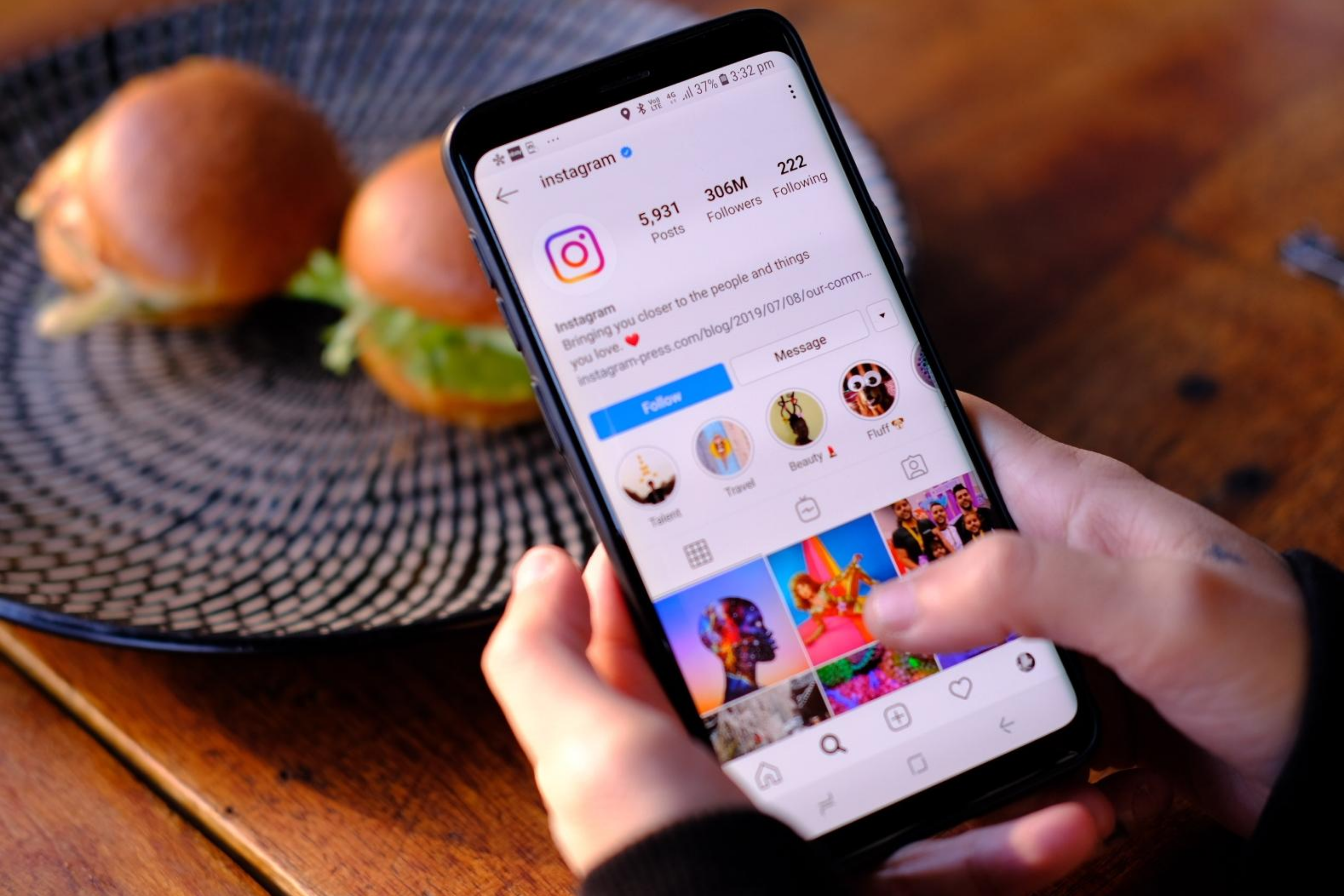
-
Instagram
Instagram is another platform that focuses mostly on visuals. Any viral content on Instagram must have a strong visual element to it.
Although you could use Instagram to build your business account and brand recognition, it may not always be the best platform for marketing, depending on your goal. This is because users are only allowed to feature a single link at a time in their bio.
Nevertheless, if you're aiming at brand exposure or selling a product, Instagram can be beneficial. The critical factor in going viral on Instagram is to find or create content that goes in line with your message or brand.
The following statistics can help you determine if Instagram would be useful for your viral campaign:
- Instagram has over 1 billion users.
- Among all major social networks, Instagram is the third most logged in.
- About 75 percent of Instagram users take action after viewing a brand's post.
-
Your own website
You may have noticed that there is also a lot of viral content that is hosted directly on the brand’s website. This is because when using your own website, there is no limit to the type of content you can share.
You can post a combination of videos, images, and text. The only limitation is the type of social media sharing buttons you have on your website. You can even include an option to send your post via email or message.
The downside to using your website to upload your content is that uses don’t immediately see the content. They need to make an extra click before the content is available to them.
There are three ways to make sure your webpage can become successful in viral marketing, and that is by:
- Ensuring that your landing page loads quickly. If it takes a long to open up after the initial click, the user will rather go back and not find out what the fuss is all about.
- Ensuring that your headline is compelling enough. Your headline is the only way for you to attract viewers. Make sure it is enticing enough to make them want to see what’s on the page, no matter how long they wait (of course, don’t make them wait too long!). Read our guide on how to write a compelling headline to achieve the best results.
- Create content that is highly shareable. Need we explain more? This is definitely a must!
Being on all social media platforms can be difficult, as going viral requires consistency. A lot of marketers choose the best three they can handle and either monitor them themselves or hire someone to do so carefully. The power of social media in viral marketing cannot be overemphasized, but it only works well when you stay involved.
3. Create Engaging Content
A conventional algorithm used by social media sites is ranking content based on how likely it is for users to engage with them, based on what the users have liked or shared in the past. They also rank content based on the post’s performance.
In other words, platforms that use this algorithm display engaging content at the top of the page and leave less engaging content at the bottom.
Amplifying engaging content keeps users interested in using the platform, and also serves as a reward for promoting exciting content. For this reason, viral marketers must pay attention to creating content that keeps users highly engaged to increases the chances of being shared.
It has been proven over time that contents with the right amount of visual elements are more likely to be shared online. In addition to the vast number of shares visual content attracts, it also persuades users to remain on your website for a more extended period because people cannot help getting drawn to visually-appealing content.
Creating this kind of content, however, is not an easy task. So, here are a few tips:
-
Increase social engagement on your blog by the use of visuals

An excellent way to engage your audiences through content is through the use of engaging blog posts. For blogs to work effectively, they have to be share-worthy. A good way to ensure this is by using images to provide a faster description of your message, along with a means to share across social media platforms with ease.
According to inc.com, when content includes images, the audience engagement produced is 650 percent higher compared to those that are made up of just text. Adding images to your writing not only helps readers grip your message faster, but it also helps them retain it.
When your message has been simplified through captivating visuals in the form of images, gifs, videos, and infographics, it increases the chances of your article getting shared and going viral.
-
Let your visuals stand alone
Since most people don't like content filled heavily with texts, it's always best to add visual elements that are entirely understandable on their own and without having to read the page's text.
When visual content conveys your message concisely and quickly, you're able to deliver more with less. When using social media, keep your posts below 250 characters, as this is proven to be an effective way to engage users and cause content to go viral quickly.
However, you also have to create a balance between creating long-form content and short-form content. It all depends on your goals and what the content is calling for. Read our article on Long Form vs Short Form content to help you decide.
Tools such as Canva, PicMonkey, Placeit, and BeFunky are great for creating attractive images, and you can use tools like RecordIT, CloudApp, and LICEcap to create interesting GIFs.
During a viral campaign, visuals are more effective when it speaks for itself, along with a concise text, including a compelling title, an introductory paragraph, and a call to action.
-
Connect with your audience emotionally
Connecting with your audience on an emotional level is the best way to leave a long-term impression on them. People will enjoy sharing your content once it resonates with them emotionally, and most often, the sentiments they feel about your content extend to your brand, thereby inspiring loyalty and trust.
A study conducted by Fractl shows that happiness is what mainly drives people to share on social media. Therefore, content that evokes an emotion in line with joy has a good chance of going viral.
-
Use a compelling title
Most readers online often judge a post by its title. Due to the increasing amount of content available on the internet, users have developed a short attention span. If content does not compel users immediately, there is a high tendency most people will ignore or scroll past it.
To attract the attention of online users immediately, you must create a highly captivating title to stand out. Titles that capture the attention of users always evoke some kind of emotion, whether positive or negative.
Make use of feeling words to add an element of excitement to your content titles. For example, instead of plainly saying 'Sign up for our writing retreat,' you could make the title more interesting and compelling by saying 'Secure your spot now to gain access to writing secrets.'
4. Get Your Audience To Create Content
A very interesting way to go viral is by making your audiences create content themselves concerning your campaign theme. This form of engagement goes beyond just sharing. It makes your content interactive.
Instead of making users share content made by your company, you could make them share content they created while simultaneously promoting your brand. This technique works well when the theme is very engaging as friends of participants will be naturally compelled to participate too.
An excellent example is in the marketing of the 'Straight Outta Compton' movie. A viral campaign was organized that caused users to generate and share personalized memes on the phrase, 'Straight Outta,' with an online meme generator tool.
This campaign created so much excitement about the movie and aided in its success. Many marketers make use of this technique to promote their products and services, and it works most of the time because users have fun while engaging in such campaigns and sharing across different social media platforms.
The more people share user-generated content in relation to your campaign, the farther your brand reaches. Your users are the focus; your users become “popular” themselves. They would feel like they are representing your brand. This strategy takes engagement a step further.
5. Release Your Content At The Perfect Time
To ensure your content is viewed by the maximum number of people fast, it is important to time its release.
Timing the release of your content depends on the social media platform you're using, along with the habits and preferences of your audience. In order to know the right time your content could possibly go viral quick, you have to keep up with the latest trends and topics, because being aware of what's going on the moment will help you create content that will easily go in line with recent happenings and capture users' attention.
Remember that most social media platforms use algorithms to rank content-based user engagement. So, if your content is similar to what users already engage with, there is a high probability that your content will be amplified on those platforms.
Another factor to consider in terms of timing is the peak time. There are certain times of the day when social media users are most active.
Releasing your content at those peak times plays a critical role in the impact you will have on the audience and is the best way to increase brand exposure organically.
But when is the peak time to upload content on social media? Here are some tips to help you determine the best time for your specific audience:
- Facebook: Although experts have suggested particular hours of the day that are best for businesses to post on Facebook, this information doesn't always hold true since there are several factors to consider such as type of industry, location of the audience, when they are online, and whether you're sponsoring your post or not.
One of the best ways to determine a good time to post on Facebook is by making use of Facebook Insights. The Insights button is located at the top of the Facebook page and gives a wealth of data on your fans' activities. Once you access the Insights option, click on 'Posts' in the left-hand column to view a breakdown of the days and time that your fans are most active on the platform. - Pinterest: Many people suggest that the best time to post on Pinterest is during the weekends. However, to be sure, you can access fans' statistics on your Pinterest page by visiting analytics.pinterest.com. There, click on Audience and then Demographics to get useful information about your follower’s activities.
- LinkedIn: Due to the business nature of this platform, it is believed that the ideal time to post is during work hours. Nevertheless, there is a simple way to determine the best time for your brand and audience.
LinkedIn's analytics only includes an overview of all your posts, along with a breakdown of your followers and growth. To determine the perfect time to publish your content, you can make use of free tools like SimplyMeasured and CoSchedule. - Instagram: If you have an Instagram business account, all you need to do to find out the best days and times to post for your audience is to access the Analytics option.
If you don't have a business account, however, you can also use some free tools such as SimplyMeasured and Union Metrics to get this information.
6. Boost Visibility With Paid Advertising And Social Media Influencers
Most times, instant virality is challenging to achieve in a viral campaign, which is why investing in paid ads is essential. Paid ads give your viral content that initial push it needs to attain a certain amount of visibility before the audience takes over, and the ball starts rolling in.
Native advertising work great for this objective. When pushing for virality, it’s good to make the viewers feel as if the post was shown to him or her naturally; as if the website he is viewing recommended the post because it is already popular. Native ads can do that as this ad format blends well with the environment.
Another excellent strategy to use while creating a paid ads campaign is to target a group of influencers in your niche. Once your engaging content catches their interest, and they re-share to their vast audience, your brand will be broadcast to an even broader audience and your content would become viral in a very efficient and cost-effective way.
Most of the marketers who make use of influencer marketing strategy says that it is advantageous. Social media influencers can improve the reach and visibility of brands and can fuel-up a viral marketing campaign.
There are several reliable tools you could employ to find social media influencers in different niches and on various social media networks, and they include Buzzsumo, Followerwonk, Hootsuite, and TrendSpottr.
7. Call Users To Action
After creating very engaging content and capturing attention on social media, it may all go to waste if there is no clear call to action. You must make it clear to those captivated by the brand, what to do next after liking, and re-sharing your content.
Recognized brands like Facebook did not just grow by creating awareness of their brand through social media. They took the extra step of encouraging their audience to take a specific action.
Often, telling your target audience to make a discounted purchase or sign up for a free trial works effectively in getting people to engage with your content and growing your customers through viral marketing.
Ideally, a good call to action should be visible, contain a compelling message, and have supporting elements such as testimonials or pictures.
Examples Of Successful Viral Content Campaigns And Why They Worked
There’s no better way to illustrate how effective viral marketing can become than by providing examples. Here are some of the best we could find:
1. The opinion piece "An open letter to my friends who support Donald Trump"

2017 witnessed an increase in the number of political posts created on social networks, and a majority of them were about the current U.S. President, Donald Trump.
When he was inaugurated, social media became filled with people who either support or detest the President, and this article was notable among them. This viral content was published as an open letter to express the writer’s opinion about those who supported the President.
It got shared over two million two hundred thousand times across social media platforms and became one of the most viral articles of that year.
Why it went viral:
- The content creator took advantage of the trending topic at that moment. Since it was the most talked-about topic by audiences at that time, it was easy to share.
- The content had a compelling headline that quickly captured the attention of audiences.
- It was a political post that agreed with the views of a good number of people, and people like to share posts that conform to their beliefs and opinions.
2. "The Man Your Man Could Smell Like," An Old Spice Marketing Campaign
The American Brand for male grooming products, Old Spice, launched a video ad campaign that went viral in a short time.
In 2010, the brand came up with its exciting brand character, The Old Spice Man. The campaign was humorous and out of the box and quickly grabbed the attention of female audiences and, at the same time, gave men reasons to buy the Old Spice products.
The video received a lot of favorable reviews and over fifty-seven million views to date. The result of the campaign was an increase in brand awareness and trust as its twitter followers increased by over a thousand percent, with over six hundred thousand likes on Facebook.
Why it went viral:
- It was a very creative marketing campaign that tapped into the emotions of its viewers.
- The Old Spice Man responded to selected tweets with custom videos in 24 hours, which left the global audience in awe.
- The marketers responded to tweets of celebrities like Rose McGowan, Kelvin Rose, etc. which helped it gain popularity.
3. OREO Cookie's Dunk in the Dark
Power out? No problem. pic.twitter.com/dnQ7pOgC
— OREO Cookie (@Oreo) February 4, 2013
The Super Bowl is usually a super competitive period for marketers with expensive 30-seconds advertisement spots, but Oreo went round the fancy ad posts with just one tweet. This tweet shot the company to the top of the market and remains one of the most viral marketing strategies of all time. This tweet, which was in the form of a picture was made when a blackout occurred at the Mercedes Superdome for 30 minutes, Oreos seized the opportunity and made the viral tweet and briefly stole the attention from the game. It greatly impacted the world of marketing as it changed the views of many marketers on the functions of social media.
Why it went viral:
- They were ready and strategically exploited the timing.
- Visuals were used to capture the attention of viewers.
- It had a unique style of marketing that appealed to a lot of people and changed people's view of marketing around the whole world in the process.
4. The article "40 Belief-shaking Remarks From A Ruthless Non-conformist"
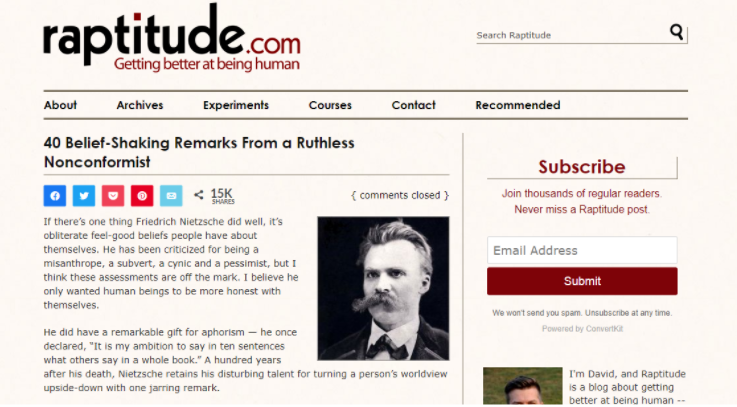
The list type article from Raptitude has a headline containing strong words like ‘belief-shaking’ and ‘ruthless’ which gives an idea that the contents of the article could change the way you see things.
The article is about the remarks made by a Non-conformist named Friedrich Niezsche, a man known for nerve hitting talents that could turn your beliefs upside-down. He was heavily criticized for misanthropic and cynical statements, but the article asserts that he might have wanted humans to apply honesty to themselves.
It was his ambition to rewrite what others have said in a book in ten words. Though many of his statements remain controversial, a lot of people around the world may agree with them, while others may detest the idea of it.
The article had 40 of Friedrich’s statements, which the author felt deserved the most attention. This content enjoyed over fourteen thousand shares on Facebook.
Why it went viral:
- The article adopted the list post format, which is the kind of content format readers understand and share easily.
- The content has an interesting headline with strong words to evoke emotions and compel readers to go through the rest of the article.
- The article itself also stirred people’s emotions and made many readers realize something they didn’t.
5. ALS Ice Bucket Challenge
The ice bucket challenge campaign is one of the most viral campaigns in the history of charity. It involved pouring a bucket of ice water over a person's head, either by himself or by someone else.
It aimed at increasing the awareness of the illness called Amyotrophic Lateral Sclerosis (ALS) and also get donations for research. The campaign went viral in 2014 and had many people participating in the campaign.
People were nominated to take part in the challenge while being filmed and then made to choose others to either try the challenge or donate. The charity was a huge success that raised more than $115 million for the ALS research, and more than 17 million people participated worldwide.
Why it went viral:
- The campaign had a substantial social currency as everything about the campaign had a noble cause, which made people participating in it look good. It was also a funny thing to do.
- The campaign had a trigger that made sharing necessary. The trigger was the nomination of people in the public to do the challenge which people could not refuse.
- The campaign evoked positive emotions. There were smiles and laughter in every video filmed even though it was about a disease.
- The campaign made use of user-generated content to engage the audience.
6. Frito Lay's 'Do me a flavor' Campaign
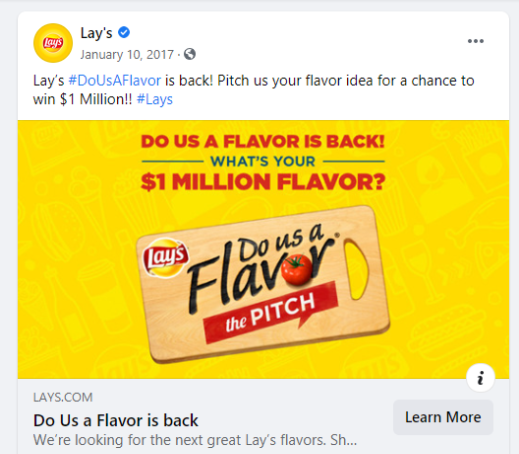
Not every brand makes viral content only to create awareness. Such is the case with the 'Do me a flavor' campaign.
In 2012, the campaign was designed to create a buzz in hopes that there would be an increase in sales. People were invited to create their flavor of chips. Three characters were selected, and the winner was given a sum of one million dollars.
They made a Facebook app to make the campaign appealing to Millennials. The results were a total of three million eight hundred thousand flavor submissions though a total of One million two hundred submissions was expected. It was through this campaign that the world was gifted with a new flavor of potato chips: Sriracha.
Why it went viral:
- It allowed a massive number of people to get involved in the selection of new flavors. Engaging your customers in matters relating to your brand is one of the effective ways to make your content viral.
- It tapped in the passion people had for potato chips to renew the enthusiasm of its customers.
- It had an incentive, which was the prize money. It led to high numbers in participation.
- The brand made participation easy. It just required submissions of the proposed flavor during a twelve-week window.
- The social media post about the contest also contained the right amount of visuals.
- The post contained compelling text.
7. Poo-Pourri's “Girls Don't Poop” Campaign
In an attempt to step into the limelight, Poo-Pourri came up with a video that went beyond the viral code and attracted the attention of millions of people. Its unique use of toilet humor left people amazed and convinced about the product.
Since its release on YouTube, the prominence of Poo-Pourri stretched over multiple social platforms and had its fan base increase by a significant amount. Most importantly, the brand treated its customers with a positive attitude.
Although their reply rate was only about 10%, the brand reacted and acknowledged posts made by their fans. This action is still commendable because the replies that the brand gave to comments and tweets were not robotic. Instead, they were personalized answers.
The video currently has a whopping forty-three million views and still increasing.
Why it went viral:
- Its way of humor attracted customers to the brand. Pulling off a feat with Toilet humor is difficult as it may appear crass to some people, but Poo-Pourri handled this well, and it resulted in their campaign going viral.
- The brand's customer relationship was significant in the success of its campaign. It kept its customers entertained on its Facebook page with its 10-1 strategy, which meant for every sale, ten posts would be made.
As you would notice in all our examples, the content either draws from your emotion (anger, frustration, excitement, hilarity) or asks for your participation.
Start Your Viral Campaign Now!
Just as its name implies, viral content spreads like a virus across the internet. The concept of using viral content in marketing is appealing to marketers because it is an inexpensive and yet effective way of gathering the attention of a massive audience while having a positive effect on the brand's image.
Creating viral content can be challenging, and a lot of times requires a great deal of luck. Nevertheless, the tips given in this article provide ways to help businesses achieve virality.
When organizing a viral campaign, marketers have to create content that uniquely and emotionally speaks to the target audience while adding value to them, as these kinds of online materials are what users enjoy and commonly share.
Although creating the perfect content takes up a huge chunk of this technique, timing its release also matters.
Marketers can make use of current trends and analytics to determine the best time to publish their content and get users engaged in it. What really drives viral content is amplification, and the right timing can help you achieve this.
Another way to achieve amplification is by the use of paid ads to help kick start the process. If you need help with kick-starting your viral campaign through native ads, we're here for you! Send us a message at love@brax.io today.

